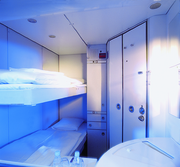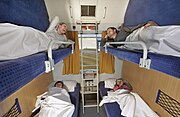City Night Line
This article needs additional citations for verification. (July 2011) |


City Night Line (abbreviated CNL, white & red livery) is a category of night trains in Europe. They were originally operated by the former railway company CityNightLine AG. Like DB AutoZug GmbH, the company was a wholly owned subsidiary of Deutsche Bahn and was integrated in the DB Group as from 1 January 2010 in the form of an asset deal.
History
In 1998, Deutsche Bahn hived off its night train services, which were provided with the train categories EN (EuroNight) and UEx (Urlaubsexpress), from DB Fernverkehr AG to DB AutoZug GmbH. One year later, the CityNightLine AG company, domiciled in Zurich and until then a joint venture operated by Deutsche Bahn and the state-owned railways of Austria and Switzerland, ÖBB and SBB, became a wholly owned subsidiary of DB Fernverkehr AG. It was run by the same management team as DB Autozug GmbH, so that responsibility for all night train categories, which still form the core element of the City Night Line network, lay with one single source from then on. The management of services, rolling stock and pricing of CityNightLine and its German counterpart, however, remained separate.
Parallel to the integration of the two companies, the DB Autozug GmbH night trains were renamed "DB Nachtzug". On introduction of the new timetable on 15 December 2002, the DB Nachtzug portfolio was increased to 20 trains.[1] Following the emergence of low-cost airlines and the expansion of the international high-speed rail network, DB realised it had to adapt its night train services to the changing requirements of the transport market. The target was to establish overnight services as a supplementary product to high-speed trains over long distances (between 800 and 1500 km). To achieve that objective, the existing train categories CityNightLine (CNL), DB NachtZug (NZ) and UrlaubsExpress (UEx) were amalgamated to form one new product called City Night Line (CNL), which was integrated in the fare systems and sales processes of the different departure countries. The line network was then redesigned to reflect these new objectives: routes which ran parallel to long-distance services were discontinued, other routes were systematically extended, destinations with strong seasonal fluctuations and tourist destinations were replaced by daytime services.
In the course of this bundling process, older passenger cars were taken out of service. Since then, the entire fleet of sleeping, couchette and seated cars has been fully air-conditioned. The cars were given a uniform livery in white with red window stripe and all-white doors. The service was standardised on all lines.
Train features
City Night Line trains are made up of compartment or open-saloon coaches with reclining seats, couchette cars, sleeping cars and dining cars. All lines have a special compartment for passengers with restricted mobility. To facilitate the carriage of luggage, either combined couchette and luggage cars are used or seated cars with a special luggage/bicycle compartment. New sleeping cars were designed specially for City Night Line and 2 different types are currently in use: the double-deck sleeping car (type 171.X and 172.X) and Comfortline (type 173.1). The cars are air-conditioned and each compartment has two or three berths, Deluxe cars have a private bathroom (shower, washbasin and WC). There is otherwise a washbasin in each compartment; shower and WC are in the aisle. Laptop connections are only available in the newer Comfortline cars. The compartments have "normal" beds.
The couchette and seated cars were converted from existing Deutsche Bundesbahn and Deutsche Reichsbahn coaches. Couchette cars have 4 or 6 berths and there are three different categories in use, which differ in respect of their additional functions:
- Couchette car (type 248.5)
- Couchette car with compartment for passengers with restricted mobility (type 249.1)
- Combined luggage and couchette car (type 874.1)
The seated cars consist of compartment cars (six seats per compartment; type 236.9) and open-saloon cars with reclining seats (types 875.X)
Transport services
The aim of the City Night Line network is to supplement the European long-distance network on long routes. Journey times of six hours or more are shifted to night-time slots so that passengers can sleep as they travel without losing unnecessary time.
City Night Line trains are operated in a through coach system. From their joint departure station, they cover part of the route together as one train; on arrival at a certain station, they are split up and joined to other trains, with which they then continue to the different destination stations. The same procedure applies on the return journey.
For example, the trains on the Amsterdam – Munich and Amsterdam - Zurich routes run as a joint train as far as Mannheim, where the train is split up. The train section travelling to Munich is joined to a train coming from Paris with destination Munich, while the section travelling to Zurich is joined to a CNL coming from Hamburg. On the changeover to the 2009/2010 timetable, the number of these shunting processes was reduced to one per network.

| Train number | Train name | Route | Note |
|---|---|---|---|
| CNL 1287/1286 | Pyxis | Hamburg–Munich | |
| CNL 451/450 | Perseus | Paris–Berlin | Ends 13 December 2014[2] |
| CNL 40418/40451 | Cassiopeia | (Innsbruck)–Munich–Paris | Ends 13 December 2014[2] |
| CNL 40463/40462 | Pictor | Munich–Venice | |
| CNL 419/418 | Pollux | Amsterdam–Munich–(Innsbruck) | |
| CNL 40419/40478 | Pegasus | Amsterdam–Zurich–(Chur) | |
| CNL 1259/1258 | Sirius | (Binz)–Berlin–Zurich | |
| CNL 458/459 | Canopus | Prague–Zurich | |
| CNL 1246/1247 | Capella | Munich–Berlin | |
| CNL 479/478 | Komet | Hamburg–Zurich–(Chur) | |
| CNL 485/484 | Lupus | Munich–Rome | |
| CNL 40485/40484 | Apus | Munich–Milan | |
| CNL 457/456 | Kopernikus | Amsterdam–Prague | Limited to Oberhausen-Prague from 14 December 2014[2] |
| CNL 40479/50451 | Andromeda | Hamburg–Paris | Ends 13 December 2014[2] |
Fares and prices
Germany

Fares for CNL services are allocated to the IC/EC Product Category (formerly Product Category B), the second-highest in the three DB passenger transport categories. All saver fares for long-distance services and the corresponding discount options (such as BahnCard) can also be used on City Night Line routes.
The special offers for long-distance services which have meanwhile been introduced (such as the Lidl-Ticket or Tchibo-Ticket) are normally valid, but not always on all City Night Line routes. Passengers have to check the conditions of the individual offer.
Tickets can be purchased a maximum of three months before the first day of validity. Tickets for group travel can be purchased up to twelve months in advance, provided that the relevant timetable has already been published.[3] In addition to the train ticket, passengers also have to make a reservation (see above for exceptions). The reservation is simultaneously valid as the charge for the additional night-time services and the prices vary according to comfort category.
Other countries
- Netherlands
In the Netherlands, City Night Line tickets are generally sold as a global fare, like the fares which apply to transit routes in Germany. Passengers who already have a rail ticket (e.g., Interrail passengers) can purchase reservations separately.
- Austria
Like the Netherlands
- Switzerland
Like Germany. In view of the high share of transit traffic, i.e., passengers heading to the Netherlands, Czech Republic or Denmark, there is a high share of global fare tickets.
- France
In France, tickets for CNL trains are sold in line with the SNCF ticket system. This is a global fare system with certain special national features (e.g., special fare rates for senior citizens and junior passengers). One special condition in France is that passengers travelling in a 4-berth couchette car have to have a 1st class ticket.
- Italy
The principle is similar to that in France, but with a few special national features.
See also
References
Notes
- ^ Fahrplanwechsel. In: Eisenbahn-Revue International, Heft 11/2002, ISSN 1421-2811, S. 498 f.
- ^ a b c d DB shrinks City Night Line network
- ^ Beförderungsbedingungen für Personen durch die Unternehmen der Deutschen Bahn AG (BB Personenverkehr), Punkt 2.1, mit Stand vom 1. September 2007.
Further reading
- Groundwater, Ben (30 April 2013). "Why trains are better than planes". The Sydney Morning Herald. Retrieved 1 May 2013.
- von Uslar, Moirtz (16 July 2010). "Freitagnacht im Schlafwagen nach Zürich". Die Zeit. Retrieved 28 March 2013.
{{cite news}}: Unknown parameter|trans_title=ignored (|trans-title=suggested) (help) Template:De icon
External links









